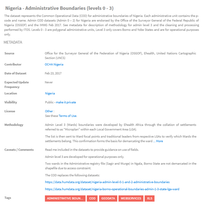Version Française disponible en bas de page
...
Overview
...
Metadata is data about data or data that defines or describes other data. Metadata is additional information or documentation about your dataset that will make it easier for others to understand and put your data into context. Good metadata is critical in humanitarian response as datasets are often incomplete or the “best available” and have limitations or discrepancies. Noting the issues related to the datasets allows others to understand how and if they can use the datasets.
...
It improves understanding of the dataset (reduces questions and confusion of its use and history)
Increases credibility/reliability of data
Provides transparency about data that is not complete or not perfect (sets expectations and can provide the purpose of the dataset)
It can increase interest by others who may have data you are missing
It can improve the discoverability on HDX or other data sharing sites. For an explanation of HDX recommended metadata please read this guide.
Where Metadata can be found
...
on HDX | In / with the Dataset | in COD-AB web services |
|---|---|---|
|
|
|
|
|
|
3 Tiered Process of Metadata
...
To balance the need for metadata against the burden of creating and maintaining it, OCHA recommends a 3-tiered system of metadata options:
Tier 1: Emergency Metadata
Tier 2: Basic Metadata
Tier 3: Full Metadata
...
Emergency metadata recognizes the fact that during times of crisis, there is likely to be no metadata. Production and sharing of datasets is happening too quickly to allow for formal detailed metadata. In those cases, the best approach is to make sure that the dataset is, to the extent possible, self-explanatory. The Emergency Metadata approach requires:
Dataset filenames are according to the naming convention
Unnecessary attributes are removed (see the Verifying Attributes and Features section of the Geodata Preparation Manual)
Attribute names are clear
If some attributes are too complex to be easily understood from the attribute name, add a simple text file to the dataset distribution explaining the attribute names. This file should have the exact same name as the dataset with _METADATA.txt added at the end. The Basic Metadata Template can be used for this purpose, though in this case, only the Data Dictionary element is needed.
...
Metadata Guide which provides an outline of the metadata required for HDX.
Be clear about the license type (see Data Agreements and Sharing)
Metadata in the COD lifecycle (prezi created by ITOS)
Métadonnées
...
Description
...
Les métadonnées sont des données [informations] fournissant des informations sur d’autres données. Des informations telles que : la source de données, la date de l’ensemble de données, la façon dont l’ensemble de données peut être partagé, mais également d’autres détails sur leurs utilisations. La création de métadonnées est fondamentale pour s’assurer que le droit d’auteur des données est préservé et que toutes les particularités de l’utilisation des données sont respectées. Tout le monde apprécie le fait d'avoir beaucoup de métadonnées associées à leurs ensembles de données, cependant, la création et la maintenance de ces métadonnées sont généralement très fastidieuses pendant les opérations sur le terrain.
...
Pour équilibrer le besoin de métadonnées et «la complexité de leur création et mise à jour, OCHA recommande un système à trois niveaux d’option pour les métadonnées :
Niveau (Tier) 1 : Métadonnées d’urgence
Niveau (Tier) 2 : Métadonnées de base
Niveau (Tier) 3 : Métadonnées complètes
Niveau 1 : Métadonnées d’urgence
...


